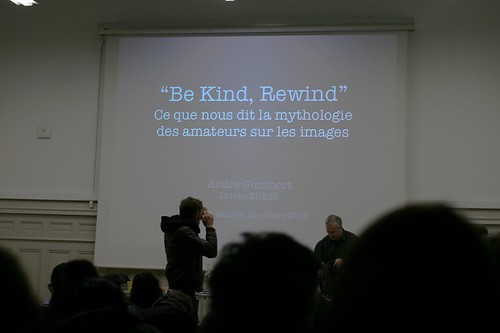 Raw notes from a presentation by André Gunthert at the Geneva University of Art and Design the other say:
Raw notes from a presentation by André Gunthert at the Geneva University of Art and Design the other say:
Amateur photography appeared around 1880, after the transition between silver to silver-chloride... which led to photojournalism and scientific photography such as the work of Albert Londe. Curiously, Londe always referred to his work as an "amateur", although he was the medical photographer at the Salpêtrière Hospital in Paris (and perhaps one of the most famous chronophotographer with Étienne-Jules Marey. Gunthert's claim is that the reason why a photo expert such as Londe referred to him as an amateur was because he lived in a transitional time between the Daguerreotype and the new popular activity of photography. Claiming to be an amateur was a peculiar stance, an avant-garde choice that aimed at showing others that "he was on the other side, a promoter of the new technique".
The end of the 19th century saw the emergence of the new figure of the amateur, through Kodak's release of their camera ("You press the button, we do the rest"). To be an amateur at the time would be described today as being a "user" and it's because of the arrival of this stance that amateurs has been opposed to professionals.
However, it's only around 2005-2005 that amateurs became a threat to professionals. Gunthert traces this back to the London subway bombings. This event in July of 2005 can be seen as a turning point in global news coverage; especially because the news (BBC) asked survivors/witness to send them images (taken with cameraphones)... simply because they could not go there.
In parallel, Gunthert describes how the Web started to build its own mythology around the amateur ("We the Media" by Dan Gilmor, citizen journalism, the web2.0 slogan by Tim O'Reilly, etc.)... and eventually services such as YouTube in 2005 were explicitly built (and valued) for their capability to be based on "user-generated content".

To him, the best example of this trend is Be Kind Rewind, a sort of testimony to the notion of Amateur culture. Gunthert describes this movie as the nicest way to depict user-generated content because it shows HOW IT WAS SUPPOSED TO BE. A sort of YouTube were viewers will act as participant and create their own videos. This kind of expectations of course lead to laws and measures taken by governments in certain countries to help the the cultural industry... because lots of people believed in this myth.
But this vision did not materialize. He described them as self-fulfilling prophecies proposed by web gurus and showed that most of the content on platforms such as YouTube are not creations. There is indeed a great shift from television to platforms like YouTube but it's mostly an archive of past productions (with tons of copyright infringements). It's not only an archive but there are also ads and new forms of communication proposed by companies (see the Evian roller babies campaign).
He concluded by stating that most of the interest by researchers/media has been drawn so far to the production part of usage and that he is more interested in how people use these platforms. YouTube is now the second the web search engine and people access it to look for answers (e.g. how to fold a tent). To Gunthert, we are in 2009 in a situation close to the one people in the 20th century encountered with sound recording devices. At the time, inventors and industrial companies has high expectations about these machines, they were supposed to help produce content and store memories of people. But it did not happen and it was mostly employed to listen to music. Nevertheless this does not mean that people were passive and there are lots of interesting and active practices with regards to sound recording devices.
Why do I blog this? my notes here are a bit messy and incomplete. I tried to translate this roughly into English but I was quite interested by his approach. Of course, some other things could be added about the DIY culture and perhaps my transcription is a bit shaky but I found it intriguing to deconstruct the notion of amateurs and usage.